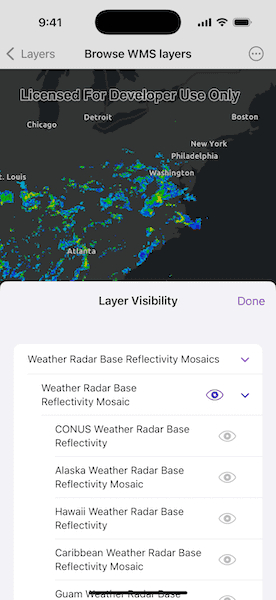Connect to a WMS service and show the available layers and sublayers.

Use case
WMS services often contain many layers and sublayers. Presenting the layers and sublayers in a UI allows you to explore what is available in the service and add individual layers to a map.
How to use the sample
- Open the sample.
- Tap "Layer Visibility" to see a hierarchical list of layers and sublayers.
- Select a layer to enable it for display. If the layer has any children, the children will also be selected.
How it works
- A
WMSServiceis created and loaded. WMSServicehas aserviceInfoproperty, which is aWMSServiceInfo.WMSServicehas aWMSLayerInfoobject for each layer (excluding sublayers) in thelayerInfoscollection.- Models are recursively created for each sublayer.
- The model has an
isVisibleproperty which sets the visibility for the associated sublayer.
- The model has an
- Once the layer selection has been updated, a
WMSLayerwith the selected sublayers is created and added to the operational layers of the map.
Relevant API
- WMSLayer
- WMSLayerInfo
- WMSService
- WMSServiceInfo
About the data
This sample shows Weather Radar Base Reflectivity Mosaics produced by the US NOAA National Weather Service. The service provides weather radar data from the NWS & OAR Multi-Radar/Multi-Sensor (MRMS) System.
Tags
catalog, OGC, web map service, WMS
Sample Code
BrowseWMSLayersView.swift
// Copyright 2025 Esri
//
// Licensed under the Apache License, Version 2.0 (the "License");
// you may not use this file except in compliance with the License.
// You may obtain a copy of the License at
//
// https://www.apache.org/licenses/LICENSE-2.0
//
// Unless required by applicable law or agreed to in writing, software
// distributed under the License is distributed on an "AS IS" BASIS,
// WITHOUT WARRANTIES OR CONDITIONS OF ANY KIND, either express or implied.
// See the License for the specific language governing permissions and
// limitations under the License.
import ArcGIS
import SwiftUI
/// A view that allows you to select visibility of WMS layers.
struct BrowseWMSLayersView: View {
/// The map that we will display the WMS layer on.
@State private var map = Map(basemapStyle: .arcGISDarkGray)
/// The service we will access to display WMS data.
@State private var wmsService = WMSService(
url: URL(string: "https://nowcoast.noaa.gov/geoserver/observations/weather_radar/wms?SERVICE=WMS&REQUEST=GetCapabilities")!
)
/// The error, if any, that occurred.
@State private var error: Error?
/// The selected visible layers to display in the `WMSLayer`.
@State private var selection: [WMSLayerModel] = []
/// Models that allow us represent WMS layer infos.
@State private var layerModels: [WMSLayerModel] = []
/// A Boolean value indicating if the layer visibility list is showing.
@State private var isListPresented = false
var body: some View {
MapView(map: map)
.task {
do {
// Load the WMS service, access the layer infos, and turn
// them into models.
try await wmsService.load()
let layerInfos = wmsService.serviceInfo?.layerInfos ?? []
layerModels = layerInfos.map(WMSLayerModel.init(layerInfo:))
} catch {
self.error = error
}
}
.toolbar {
ToolbarItem(placement: .bottomBar) {
Button("Layer Visibility") {
isListPresented.toggle()
}
.disabled(layerModels.isEmpty)
.popover(isPresented: $isListPresented) {
NavigationStack {
WMSLayerListView(models: layerModels, selection: $selection)
.navigationBarTitleDisplayMode(.inline)
.navigationTitle("Layer Visibility")
.presentationDetents([.medium])
.toolbar {
ToolbarItem(placement: .topBarTrailing) {
Button("Done") {
isListPresented.toggle()
}
}
}
}
.frame(idealWidth: 320, idealHeight: 380)
}
}
}
.onChange(of: selection) {
map.removeAllOperationalLayers()
guard !selection.isEmpty else { return }
let wmsLayer = WMSLayer(layerInfos: selection.map(\.layerInfo))
map.addOperationalLayer(wmsLayer)
}
.errorAlert(presentingError: $error)
}
}
extension BrowseWMSLayersView {
/// A view that displays the layers and sublayers in a hierarchical list.
struct WMSLayerListView: View {
/// The models to display in the list.
let models: [WMSLayerModel]
/// The selected models that represent layer infos that we will display
/// in the `WMSLayer` on the map.
@Binding var selection: [WMSLayerModel]
var body: some View {
List(models) { model in
OutlineGroup(models, children: \.children) { model in
HStack {
Text(model.layerInfo.title)
Spacer()
if model.kind == .display {
Button {
model.isVisible.toggle()
} label: {
Image(
systemName: model.isVisible || model.isParentVisible ? "eye" : "eye.slash"
)
}
.buttonStyle(.borderless)
// Disable the button if the parent is visible because
// the sublayer will always display in that case.
.disabled(model.isParentVisible)
.padding(.trailing)
}
}
.font(.subheadline)
.animation(.default, value: model.isVisible)
.onChange(of: model.isVisible) { updateSelection() }
}
}
}
/// Updates the selection for given `isVisible`.
private func updateSelection() {
func visibleItems(startingWith model: WMSLayerModel) -> [WMSLayerModel] {
// If the starting one is visible, return that only because
// child visibility doesn't matter when the parent is visible.
guard !model.isVisible else { return [model] }
guard let children = model.children else { return [] }
return children.flatMap { visibleItems(startingWith: $0) }
}
selection = models.flatMap { visibleItems(startingWith: $0) }
}
}
}
extension BrowseWMSLayersView {
/// The model for a WMS layer info.
@Observable
final class WMSLayerModel: Equatable, Identifiable {
/// The layer info that this model wraps.
let layerInfo: WMSLayerInfo
/// Creates a model with a given WMS layer info.
init(layerInfo: WMSLayerInfo) {
self.layerInfo = layerInfo
if !layerInfo.sublayerInfos.isEmpty {
children = layerInfo.sublayerInfos.map(WMSLayerModel.init(layerInfo:))
} else {
children = nil
}
}
/// The kind of layer info.
var kind: Kind {
// If the WMS layer does not have a name but has a title,
// it is just a category for other sublayers.
layerInfo.name.isEmpty ? .container : .display
}
/// The child layer models.
let children: [WMSLayerModel]?
/// A Boolean value indicating if the parent is visible.
var isParentVisible = false
/// A Boolean value indicating if the layer is visible.
var isVisible = false {
didSet {
// Update the children's `isParentVisible` property.
children?.forEach { $0.isParentVisible = isVisible }
}
}
static func == (lhs: WMSLayerModel, rhs: WMSLayerModel) -> Bool {
lhs.layerInfo === rhs.layerInfo
}
}
}
extension BrowseWMSLayersView.WMSLayerModel {
/// The kind of WMS layer info.
enum Kind {
/// A layer info that is just a category for other sublayers.
case container
/// A layer info that can be displayed.
case display
}
}
#Preview {
BrowseWMSLayersView()
}